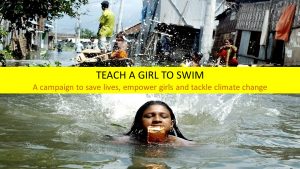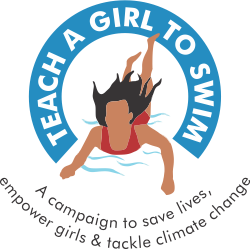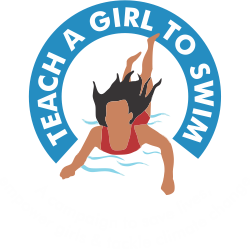The Campaign
INTRODUCING THE
‘TEACH A GIRL TO SWIM’
CAMPAIGN
Swimming 500km+ in 2018 to stop drowning deaths & get girls swimming!

Drowning is the world’s 3rd leading cause of preventable death in children after malnutrition and diarrhoea. It is the single largest killer of children in Bangladesh and the primary cause of injury death in children aged 1–14 in China. While the world has made unprecedented advances in tackling hunger and diarrhoea, drowning deaths have been largely neglected. Basic survival swimming can save lives but is rarely taught.
Women and girls are particularly vulnerable due to cultural norms regarding modesty, and often die in greater numbers than males in flood disasters. Climate change is making such weather events more frequent and intense. Paying attention to drowning deaths, and their often gendered nature, must now be a part of climate adaptation in all flood-prone countries and regions. Every country must have a strategy to address this and the skills and resources to implement it. In the words of Indian campaign founder, Malini Mehra:
“THIS IS THE FOCUS OF THE TEACH A GIRL TO SWIM CAMPAIGN. I BELIEVE THAT ACTION TO TACKLE DROWNING WILL HELP SAVE LIVES, EMPOWER GIRLS AND WOMEN, AND CONTRIBUTE TO CLIMATE RESILIENCE IN SOME OF THE MOST VULNERABLE COMMUNITIES IN THE WORLD.”
 It seeks to pair and help resource path-breaking organisations and efforts from across the world, such as the UK charity Level Water which teaches disabled kids to swim, and the INGO Collaborative Drowning Prevention in Vietnam, which is teaching a new generation of children survival swim skills. TEACH A GIRL TO SWIM also seeks to impart a love for swimming, which can have a transformative and beneficial impact on human health and well-being at any age.
It seeks to pair and help resource path-breaking organisations and efforts from across the world, such as the UK charity Level Water which teaches disabled kids to swim, and the INGO Collaborative Drowning Prevention in Vietnam, which is teaching a new generation of children survival swim skills. TEACH A GIRL TO SWIM also seeks to impart a love for swimming, which can have a transformative and beneficial impact on human health and well-being at any age.
 TEACH A GIRL TO SWIM (TAGS) seeks to raise awareness about drowning, how it can affect girls and women differently, how this risk is multiplied by climate change, and why swimming can be such an effective survival and risk reduction strategy. The campaign also seeks to bring attention and resources to organisations such as Bangladesh’s Centre for Injury Prevention and Research (CIPRB), whose lifesaving SwimSafe programmes have transformed at-risk communities in rural Bangladesh.
TEACH A GIRL TO SWIM (TAGS) seeks to raise awareness about drowning, how it can affect girls and women differently, how this risk is multiplied by climate change, and why swimming can be such an effective survival and risk reduction strategy. The campaign also seeks to bring attention and resources to organisations such as Bangladesh’s Centre for Injury Prevention and Research (CIPRB), whose lifesaving SwimSafe programmes have transformed at-risk communities in rural Bangladesh.
RAISING AWARENESS THROUGH A YEAR OF MARATHON SWIMS …

The TEACH A GIRL TO SWIM campaign was officially kicked off at the United Nations Global Platform on Disaster Risk Reduction in May 2017 in Cancun, Mexico, where Malini swam a 5km opening swim in the waters of the official venue, the Moon Palace Hotel. She is now fundraising to support the next major stage of the campaign – to which she will be devoting most of 2018 in a voluntary capacity. Over the course of 2018, she will be swimming more than 150km around the world to bring attention to the silent killer of drowning and the need to get girls swimming. With training swims included, in total she will have swum far in excess of 500km during the course of 2018.
The swims will be largely single 10km (a swim marathon) distances in each country, paired with workshops, presentations and media engagement, in partnership with local NGOs, experts, policy makers, politicians, opinion formers and decision-makers in India, Bangladesh, China, Vietnam, Japan, and the Philippines. As a policy objective, Malini emphasises :
“A key focus of my advocacy will be to ensure that safety swimming for girls is included in national climate change and disaster risk reduction strategies as an important element of the country’s adaptation to climate change.”
LONDON LIDO CHALLENGE
(25k in 5 Lidos in 5 days)

As part of TEACH A GIRL TO SWIM, Malini has created a personal swimming challenge based in her adopted home, London. In May 2018, she will swim 25km in 5 of London’s most iconic Lidos (open air swimming pools) over 5 consecutive days. This 25 in 5 in 5 challenge will engage London’s swimming, fitness, women’s & girls’ empowerment, climate and health communities, along with London’s many diaspora communities from climate-vulnerable parts of the world. Work with schools and the media will be key components of an outreach strategy of this leg of the TAGS campaign designed to raise awareness, inspire and engage.
IRONMAN BOLTON

To bring further attention to the aims of TEACH A GIRL TO SWIM within the endurance sports and triathlon community, Malini, a keen recreational triathlete, will undertake an IRONMAN triathlon in July 2019. An IRONMAN triathlon consists of a 2.4-mile (3.86 km) swim, a 112-mile (180.25 km) bicycle ride and a marathon 26.22-mile (42.20 km) run, raced in that order and without a break.
Endurance athletes and fitness enthusiasts are key communities to engage as supporters for the TAGS campaign, as both potential trainers and to bridge the resources and attention gap between elite sports pursuits and facilities available to low-income communities around the world.
For the IRONMAN challenge, Malini will be training with legendary triathlon coach, Mark Kleanthous (@ironmate), who also serves as a TAGS Advisor.
UN SUSTAINABLE DEVELOPMENT GOALS (SDGs)

The TEACH A GIRL TO SWIM campaign is also designed to actively promote and contribute to the implementation of the United Nations’ Sustainable Development Goals (SDGs) – in particular Goal 3 on good health and well-being, Goal 5 on Gender Equality and Goal 13 on climate action.
PROMOTION & PARTNERSHIP
WITH LEADING AGENCIES

The TEACH A GIRL TO SWIM campaign will be filmed and made into a documentary highlighting the global scourge of drowning deaths, how women and girls can be disproportionately affected, and what is being done to address this. The film will be part of materials produced raise awareness and help challenge prejudicial cultural norms and behaviours through a focus on raising women and girls’ self-esteem, body image, health and fitness.
TEACH A GIRL TO SWIM will work in partnership with a range of UN bodies – UN Women, UNICEF, WHO, UNDP, UNFCCC, UNISDR – and inspiring NGOs such as Save the Children, Plan International, CIPBR, INGO Collaborative Drowning Prevention in Vietnam, RNLI, Level Water, and professional bodies and corporate partners, to raise awareness and the resources necessary to effectively tackle drowning deaths and transform the lives of women and girls.
The TAGS campaign is actively supporting the work of the World Health Organisation (WHO) on drowning prevention, through raising awareness and promoting the implementation of the WHO Drowning Prevention Guide (2017) in all of the campaign’s outreach efforts.
Partners

SOME FURTHER INFORMATION ON DROWNING …
The World Health Organisation estimates that almost 360,000 people die annually worldwide due to drowning, and its 2014 report on drowning calls for action “preventing a leading killer”. So far, action has been slow to come. Bangladesh is a case in point. The most populous delta in Asia`- with 80% of the land mass a flood plain – it endures killer floods and is dangerously vulnerable to climate change. According to reports, “In the past two decades, efforts to tackle childhood infectious diseases have yielded dramatic results in Bangladesh – under-five and infant mortality declined by 65% and 56% respectively between 2004 and 2014 … Yet, despite drowning being flagged as the leading killer of children between the ages of one and 18 as far back as 2005, little has been done nationwide to tackle it.”
Although drowning is a global epidemic of preventable death – every hour of every day, in every region of the world, 42 people lose their lives due to drowning – the vast majority of these deaths take place in low and middle-income countries such as Vietnam and the Philippines.
The WHO Drowning Prevention Guide (2017) provides the most recent evidence-based set of recommendations to prevent drowning. The TAGS campaign is actively supporting implementation of its 10 recommendations in an integrated manner, including the one on ‘Teaching school-age children swimming and water safety skills’ with a particular focus on girls.
… CLIMATE CHANGE

Climate change is also emerging as a risk multiplier for this public health emergency. With climate change-induced extreme weather events such as monsoons, tropical storms, hurricanes and extreme rainfall events becoming more commonplace, intense flooding associated with these phenomenon now poses a major disaster risk. The majority of deaths caused by floods – 75% – are due to drowning. Disasters of this kind are expected to increase as climate change takes hold.
… AND WHY GENDER MATTERS
 Disasters and drowning are not gender-neutral. As we know from decades of research into the gender dimensions of disaster risk reduction, gender, along with age and disability, is a key vulnerability factor. Women and girls tend to die disproportionately more than men and boys in disaster situations, largely due to differences in social, cultural and economic rights.
Disasters and drowning are not gender-neutral. As we know from decades of research into the gender dimensions of disaster risk reduction, gender, along with age and disability, is a key vulnerability factor. Women and girls tend to die disproportionately more than men and boys in disaster situations, largely due to differences in social, cultural and economic rights.
For example, in the 2007 Bangladesh and Indonesian tsunamis, female mortality was far higher than male mortality, due to cultural norms making it less likely that young girls learn to swim (Demetriades and Esplen 2008). According to IUCN research, in the 1991 cyclone disasters in Bangladesh, 90% of the 140,000 people who died were women (Ikeda, 1995).
According to Oxfam’s research in 2005 in Sri Lanka, it was easier for men to survive during the tsunami because ‘knowing how to swim and climb trees is mainly taught to boys. This social prejudice means that girls and women in Sri Lanka have very few possibilities of surviving in future disasters.’
The need to challenge and change prejudicial cultural and social norms regarding gender difference, which can often have lethal consequences, is a key driver of the TEACH A GIRL TO SWIM campaign.
THANK YOU FOR YOUR INTEREST
AND SUPPORT.
All donations can be made here:
https://www.justgiving.com/crowdfunding/teach-a-girl-to-swim
Please do not hesitate to contact the campaign team if you want to learn more, arrange a talk at your institution, or help in any other way: contact@teachagirltoswim.org
website : www.teachagirltoswim.org

